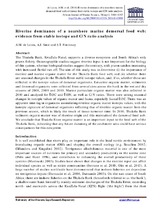| dc.contributor.author | de Lecea, A.M. | |
| dc.contributor.author | Smit, Albertus J. | |
| dc.contributor.author | Fennessy, S.T. | |
| dc.date.accessioned | 2018-05-15T10:48:05Z | |
| dc.date.available | 2018-05-15T10:48:05Z | |
| dc.date.issued | 2016 | |
| dc.identifier.citation | de Lecea, A.M. et al. (2016) Riverine dominance of a nearshore marine demersal food web: evidence from stable isotope and C/N ratio analysis. African Journal of Marine Science, 38(sup1): S181-S192 http://dx.doi.org/10.2989/1814232X.2016.1142898 | en_US |
| dc.identifier.issn | 1814-232X | |
| dc.identifier.uri | http://dx.doi.org/10.2989/1814232X.2016.1142898 | |
| dc.identifier.uri | http://hdl.handle.net/10566/3670 | |
| dc.description.abstract | The Thukela Bank, KwaZulu-Natal, supports a diverse ecosystem and South Africa’s only prawn fishery. Oceanographic studies suggest riverine input is not important for the biology of this system, whereas biological studies suggest the contrary, with prawn catches increasing with increased fluvial run-off. The aim of this study was to determine (i) the importance of riverine and marine organic matter for the Thukela Bank food web; and (ii) whether there are seasonal changes in the Thukela River stable isotope values, and, if so, whether these are reflected in the isotope values of demersal organisms. Estuarine organic matter, sediments and demersal organisms were collected from several sites across the bank in the wet and dry seasons of 2008, 2009 and 2010. Marine particulate organic matter was also collected in 2010 and analysed for δ13C and δ15N, as well as C/N ratios. There were strong seasonal changes in isotopic values of organic matter and fauna, especially faunal δ13C. There was an apparent time-lag in organisms assimilating riverine organic matter isotopic values, with the isotopic signature of demersal organisms reflecting that of riverine organic matter from the previous season, which is likely the result of tissue turnover time. In 2010, Thukela Bank sediment organic matter was of riverine origin and this maintained the demersal food web. We conclude that Thukela River organic matter is an important input to the food web of the Thukela Bank, indicating that any future damming of the catchment area could have serious consequences for this ecosystem. | en_US |
| dc.language.iso | en | en_US |
| dc.publisher | National Inquiry Services Centre (NISC) | en_US |
| dc.rights | This is the author version of the article published online at: http://dx.doi.org/10.2989/1814232X.2016.1142898 | |
| dc.subject | Demersal Fauna | en_US |
| dc.subject | Organic Matter | en_US |
| dc.subject | Riverine Input | en_US |
| dc.subject | Seasonality | en_US |
| dc.subject | Stable Isotopes | en_US |
| dc.subject | Thukela Bank | en_US |
| dc.subject | Total Suspended Solids | en_US |
| dc.title | Riverine dominance of a nearshore marine demersal food web: evidence from stable isotope and C/N ratio analysis | en_US |
| dc.type | Article | en_US |
| dc.privacy.showsubmitter | FALSE | |
| dc.status.ispeerreviewed | TRUE | |
| dc.description.accreditation | DHET | |

